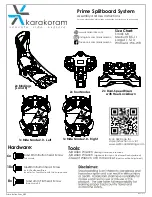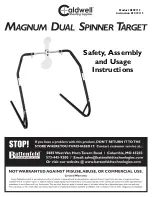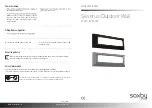
Maintenance
- (cont’d)
ALIGNMENT ………
All rotating parts -head roller, tail roller, and return idlers- must be at a 90 degree angle to the
direction of belt travel, must be level, and the midpoint of each centered on a line when properly
aligned.
Alignment is checked by running a tight wire from the center of head roller to center of the tail roller.
Level all rotating parts. If a part is not level, the belt will run to the lower side.
BELT SPLICING ………
A belt must not run out at the splice area. Runout will occur if the belt is not cut square or splice
is not installed square.
Operation
1.
Prior to the start-up, check to see that belt is free from any objects that would bind or tear.
2.
On starting for the first time, with no load on belt, apply power for a few seconds only to see
that the tender belt is well centered in the tube and on the return.
3.
It should be noted at this time that too much tension on the tender belt will make adjustment
or training much more difficult, shorten the life of the belt, and waste power. The belt should
be tensioned tight enough so the drive roller does not slip. The belt is tight when applying 25
pounds of force, centered between the return rollers, there is no more than 2 inches of
deflection.
BELT TRAINING ………
It is essential that the tender belt be properly trained at all times. For this reason, all rotating parts
should always be at right angles to the tender belt.
Slight adjustment of roller shafts may be required to keep belts centered on them i.e., if the belt
runs to one side of the roller - apply more tension to this side of the belt by advancing the roller
shaft on this side. This can be done on the head section as long as adjustment bolt does not vary
more than 1/4". If it does, and belt will still not center on both rollers, the tail section is probably out
of square.
To square tail section roller, even out the head roller until adjustment bolts are equal. On tail
section, loosen bearing bolts on opposite side the belt is off. CAUTION: LOOSEN BEARING
BOLTS JUST ENOUGH SO IT TAKES A BLOCK OF WOOD AND A SMALL HAMMER TO MOVE
THE BEARING. To adjust tail section, 1/32" in most cases, will move the belt. Tail roller bearings
only have about a 1/16" to 3/32" movement total. Tighten the bearing, and go to the head section
and retrain the belt.
If the belt tends to veer to one side of the return strand, the belt can be centered by "knocking"
ahead (in the direction of belt travel) the end of the return idler to which the belt runs. A belt
correctly installed will usually train well both empty and loaded, except as noted:
1. One or more rotating parts not in alignment.
2. Belt tensions in some part of system (usually at tail section) are below minimum
recommended.
3. Belt not loaded centrally.
When a belt is initially started, it should be jogged around the system to determine if a major runout
occurs which could damage belt and belt edges. If runout occurs at some point of the system, the
reason is usually a return idler or roller out of alignment before the runout. Alignment should be
rechecked before restarting.
After the belt can be safely run without damage, final training should begin with the head roller.
The belt must enter the head roller in the center without movement from side to side. If the belt
is not centered on the tail pulley, the return strand of belt should be observed for any section which
is not centered on the return idlers. If the belt is not centered at some point, move return idlers
starting before this point to correct centering of belt. Movement of idler bracket should be gradual
and only 1/16" to 1/8" remembering that the belt will move in the direction that it first contacts the
idler. The same corrective action should be taken at the tail roller.
After the belt is trained empty, the belt should be trained with a load. The take-up adjustments are
made to prevent belt slip and keep tensions at all points above minimums recommended when belt
is operating with a load.
If slip occurs under load, additional belt tension should be adjusting the take-up only enough to
prevent slip from occurring under load, and when started with a load.
14
Summary of Contents for Seed Box Tote
Page 2: ......
Page 12: ...Wiring Diagram For Electric Units 10 ...
Page 13: ...Wiring Diagram For Gas Units without remote 11 ...
Page 17: ...Seed Box Tote Dimensions 15 ...
Page 18: ...Seed Box Tote Stand Assembly Telescoping Tube Gas Drive Prior 2021 16 ...
Page 20: ...Seed Box Tote Stand Assembly Standard Tube Gas Drive Prior 2021 18 ...
Page 22: ...Seed Box Tote Stand Assembly Standard Tube Electric Drive Prior 2021 879643 20 ...
Page 24: ...Seed Box Tote Stand Assembly Telescoping Tube Gas Drive 63460000 22 ...
Page 26: ...Seed Box Tote Stand Assembly Standard Tube Gas Hard Wire w Actuator 63443600 24 ...
Page 28: ...Seed Box Tote Stand Assembly Standard Tube Gas Remote w Actuator 63458400 26 ...
Page 30: ...Seed Box Tote Stand Assembly Standard Tube Electric w Actuator 883868 28 ...
Page 32: ...Seed Box Tote Standard Tube Gas Drive 879106 30 ...
Page 34: ...Seed Box Tote Standard Tube Electric Drive 879635 32 ...
Page 36: ...Seed Box Tote Standard Tube Gas Remote 883744 34 ...
Page 38: ...Seed Box Tote Standard Tube Electric W Actuator 883843 36 ...
Page 40: ...Seed Box Tote Telescoping Tube Gas W Actuator 883751 38 ...
Page 42: ...Seed Box Tote Telescoping Tube Gas Drive 40 ...
Page 51: ...Remote Enclosure Assembly Actuator 883405 49 ...
Page 53: ...Remote Enclosure Assembly 63444400 51 ...
Page 58: ...Trailer RV Plug 56 ...
Page 59: ...P O Box 526 Spearville Kansas 67876 620 227 7106 crustbuster com ...
















































